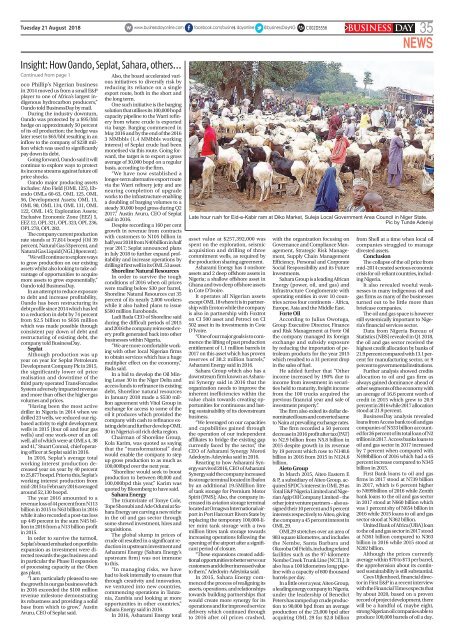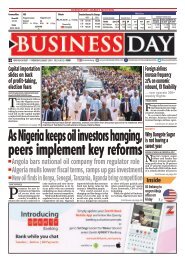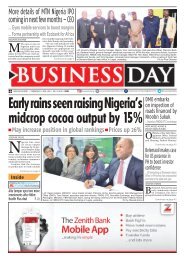BusinessDay 21 Aug 2018
Create successful ePaper yourself
Turn your PDF publications into a flip-book with our unique Google optimized e-Paper software.
Tuesday <strong>21</strong> <strong>Aug</strong>ust <strong>2018</strong><br />
Insight: How Oando, Seplat, Sahara, others...<br />
Continued from page 1<br />
oco Phillip’s Nigerian business<br />
in 2014 moved us from a small E&P<br />
player to one of Africa’s largest indigenous<br />
hydrocarbon producers,”<br />
Oando told <strong>BusinessDay</strong> by mail.<br />
During the industry downturn,<br />
Oando was protected by a $95/bbl<br />
hedge on approximately 50 percent<br />
of its oil production; the hedge was<br />
later reset to $65/bbl resulting in an<br />
inflow to the company of $238 million<br />
which was used to significantly<br />
pay down its debt.<br />
Going forward, Oando said it will<br />
continue to explore ways to protect<br />
its income streams against future oil<br />
price shocks.<br />
Oando major producing assets<br />
includes: Abo Field (OML 125), Ebendo<br />
OMLs 60-63, OML 125, OML<br />
56, Development Assets; OML 13,<br />
OML 90, OML 134, OML 131, OML<br />
122, OML 145; Exploration Assets;<br />
Exclusive Economic Zone (EEZ) 5,<br />
EEZ 12, OPL 3<strong>21</strong>, OPL 323, OPL 236,<br />
OPL 278, OPL 282.<br />
The company current production<br />
rate stands at 37,814 boepd (Oil 39<br />
percent, Natural Gas 53percent, and<br />
Natural Gas Liquid (NGL) 8percent).<br />
“We will continue to explore ways<br />
to grow production on our existing<br />
assets whilst also looking to take advantage<br />
of opportunities to acquire<br />
more assets to grow exponentially,”<br />
Oando told <strong>BusinessDay</strong>.<br />
In an attempt to reduce exposure<br />
to debt and increase profitability,<br />
Oando has been restructuring its<br />
debt profile since 2014 which has led<br />
to a reduction in debt by 74 percent<br />
from $2.5 billion to $656 million<br />
which was made possible through<br />
consistent pay down of debt and<br />
restructuring of existing debt, the<br />
company told <strong>BusinessDay</strong>.<br />
Seplat<br />
Although production was up<br />
year on year for Seplat Petroleum<br />
Development Company Plc in 2015,<br />
the significantly lower oil price<br />
realisation and downtime of the<br />
third party operated TransForcados<br />
System adversely impacted revenue<br />
and more than offset the higher gas<br />
volumes and prices.<br />
“Having been the most active<br />
driller in Nigeria in 2014 when we<br />
drilled 23 wells, we reduced our rigbased<br />
activity to eight development<br />
wells in 2015 (four oil and four gas<br />
wells) and one work-over of an oil<br />
well, all of which were at OMLs 4, 38<br />
and 41,” Stuart Connal, chief operating<br />
officer at Seplat said in 2016.<br />
In 2016, Seplat’s average total<br />
working interest production decreased<br />
year on year by 40 percent<br />
to 25,877 boepd. Prior to this, Seplat’s<br />
working interest production from<br />
mid-2015 to February 2016 averaged<br />
around 52,130 boepd.<br />
The year 2016 amounted to a<br />
revenue loss of 44 percent from N113<br />
billion in 2015 to N63 billion in 2016<br />
while it also recorded a post-tax loss<br />
up 449 percent in the sum N45 billion<br />
in 2016 from a N13 billion profit<br />
in 2015.<br />
In order to survive the turmoil,<br />
Seplat’s board embarked on portfolio<br />
expansion as investment were directed<br />
towards the gas business and<br />
in particular the Phase II expansion<br />
of processing capacity at the Oben<br />
gas plant.<br />
“I am particularly pleased to see<br />
the growth in our gas business which<br />
in 2016 exceeded the $100 million<br />
revenue milestone demonstrating<br />
its robustness and providing a solid<br />
base from which to grow,” Austin<br />
Avuru, CEO of Seplat said.<br />
Also, the board accelerated various<br />
initiatives to diversify risk by<br />
reducing its reliance on a single<br />
export route, both in the short and<br />
the long term.<br />
One such initiative is the barging<br />
solution that utilises its 100,000 bopd<br />
capacity pipeline to the Warri refinery<br />
from where crude is exported<br />
via barge. Barging commenced in<br />
May 2016 and by the end of the 2016<br />
3 MMbbls (1.4 MMbbls working<br />
interest) of Seplat crude had been<br />
monetised via this route. Going forward,<br />
the target is to export a gross<br />
average of 30,000 bopd on a regular<br />
basis, according to the firm.<br />
“We have now established a<br />
longer-term alternative export route<br />
via the Warri refinery jetty and are<br />
nearing completion of upgrade<br />
works to the infrastructure enabling<br />
a doubling of barging volumes to a<br />
steady 30,000 bopd gross during Q2<br />
2017,” Austin Avuru, CEO of Seplat<br />
said in 2016.<br />
Despite recording a 160 per cent<br />
growth in revenue from contracts<br />
with customers to N105 billion in<br />
half year <strong>2018</strong> from N40 billion in half<br />
year 2017; Seplat announced plans<br />
in July <strong>2018</strong> to further expand profitability<br />
and increase operations by<br />
drilling it first well in its OML 53 asset.<br />
Shoreline Natural Resources<br />
In order to survive the tough<br />
conditions of 2016 when oil prices<br />
were trading below $30 per barrel,<br />
Shoreline Natural Resources cut 35<br />
percent of its nearly 2,000 workers<br />
while it also halted plans to issue<br />
$500 million Eurobonds.<br />
Ladi Bada CEO of Shoreline said<br />
during the difficult periods of 2015<br />
and 2016 the company reinvested every<br />
profit generated back into other<br />
businesses within Nigeria.<br />
“We are more comfortable working<br />
with other local Nigerian firms<br />
to obtain services which has a huge<br />
multiplier effect on the economy,”<br />
Bada said.<br />
In a bid to develop the Oil Mining<br />
Lease 30 in the Niger Delta and<br />
access funds to refinance its existing<br />
debt, Shoreline natural resources<br />
in January <strong>2018</strong> made a $530 million<br />
agreement with Vitol Group in<br />
exchange for access to some of the<br />
oil it produces which provided the<br />
company with cash to refinance existing<br />
debt and further develop OML<br />
30 in Nigeria’s oil rich delta region.<br />
Chairman of Shoreline Group,<br />
Kola Karim, was quoted as saying<br />
that the “transformational” deal<br />
would enable the company to step<br />
up gross production to as much as<br />
100,000bpd over the next year.<br />
“Shoreline would seek to boost<br />
production to between 80,000 and<br />
100,000bpd this year,” Karim was<br />
quoted by Bloomberg to have said.<br />
Sahara Energy<br />
The triumvirate of Tonye Cole,<br />
Tope Shonubi and Ade Odunsi at Sahara<br />
Energy are carving a new niche<br />
in the oil and gas sector through<br />
some shrewd investment, hires and<br />
acquisitions.<br />
The global slump in prices of<br />
crude oil resulted in a significant reduction<br />
in upstream investment and<br />
Asharami Energy (Sahara Energy’s<br />
upstream firm) was not immune<br />
to this.<br />
“In managing risks, we have<br />
had to look internally to ensure that<br />
through creativity and innovation,<br />
we ventured into new countries,<br />
commencing operations in Tanzania,<br />
Zambia and looking at more<br />
opportunities in other countries,”<br />
Sahara Energy said in 2016.<br />
In 2016, Asharami Energy total<br />
C002D5556<br />
BUSINESS DAY<br />
35<br />
NEWS<br />
Late hour rush for Eid-e-Kabir ram at Diko Market, Suleja Local Government Area Council in Niger State.<br />
Pic by Tunde Adeniyi<br />
asset value at $257,392,000 was<br />
spent on the exploration, seismic<br />
acquisition and drilling of three<br />
commitment wells, as required by<br />
the production sharing agreement.<br />
Asharami Energy has 4 onshore<br />
assets and 2 deep offshore assets in<br />
Nigeria; a shallow offshore asset in<br />
Ghana and two deep offshore assets<br />
in Cote D’Ivoire.<br />
It operates all Nigerian assets<br />
except OML 18 where it is in partnership<br />
with Eroton while the company<br />
is also in partnership with Foxtrot<br />
on CI 500 asset and Petroci on CI<br />
502 asset in its investments in Cote<br />
D’Ivoire.<br />
“One of our major goals is to commence<br />
the lifting of past production<br />
entitlement of 1.1 million barrels in<br />
2017 on this asset which has proven<br />
reserves of 38.2 million barrels,”<br />
Asharami Energy said in 2016.<br />
Sahara Group which also has a<br />
downstream firm known as Asharami<br />
Synergy said in 2016 that the<br />
organization needs to improve the<br />
inherent inefficiencies within the<br />
value chain towards creating opportunities<br />
for continuous and lasting<br />
sustainability of its downstream<br />
business.<br />
“We leveraged on our capacities<br />
and capabilities gained through<br />
the operation of our independent<br />
affiliates to bridge the existing gap<br />
currently faced by the sector,” the<br />
CEO of Asharami Synergy Moroti<br />
Adedoyin-Adeyinka said in 2016.<br />
Reacting to how Asharami Synergy<br />
survived 2016, CEO of Asharami<br />
Synergy said the company increased<br />
its storage terminal located in Ibafon<br />
by an additional 19.5Million litre<br />
of tank storage for Premium Motor<br />
Spirit (PMS); Also, the company increased<br />
its aviation storage terminal<br />
located at Omagwa International airport<br />
in Port Harcourt Rivers State by<br />
replacing the temporary 100,000-liter<br />
mini tank storage with a two<br />
million litres tank storage towards<br />
increasing operations following the<br />
opening of the airport after a significant<br />
period of closure.<br />
“These expansions created additional<br />
opportunities to better serve our<br />
customers and deliver increased value<br />
to them,” Adedoyin-Adeyinka said.<br />
In 2015, Sahara Energy commenced<br />
the process of realigning its<br />
assets, operations, and relationships<br />
towards building partnerships that<br />
would create more synergy for its<br />
operations and for improved service<br />
delivery which continued through<br />
to 2016 after oil prices crashed,<br />
with the organization focusing on<br />
Governance and Compliance Management,<br />
Strategic Risk Management,<br />
Supply Chain Management<br />
Efficiency, Personal and Corporate<br />
Social Responsibility and its Future<br />
Investments.<br />
Sahara Group is a leading African<br />
Energy (power, oil, and gas) and<br />
Infrastructure Conglomerate with<br />
operating entities in over 10 countries<br />
across four continents - Africa,<br />
Europe, Asia and the Middle East.<br />
Forte Oil<br />
According to Julius Owotuga,<br />
Group Executive Director, Finance<br />
and Risk Management at Forte Oil<br />
the company managed its foreign<br />
exchange and subsidy exposure<br />
by reducing the importation of petroleum<br />
products for the year 2015<br />
which resulted to a 31 percent drop<br />
in the sales of fuel.<br />
He added further that “Other<br />
income increased by 190% due to<br />
income from investment in securities<br />
held to maturity, freight income<br />
from the 100 trucks acquired the<br />
previous financial year and sale of<br />
investment property”.<br />
The firm also exited its dollar denominated<br />
loans and converted same<br />
to Naira at prevailing exchange rates.<br />
The firm recorded a 50 percent<br />
decrease in 2016 profit after tax (PAT)<br />
to N2.9 billion from N5.8 billion in<br />
2015 despite growth in its revenue<br />
by 19 percent which rose to N148.6<br />
billion in 2016 from 2015 in N124.6<br />
billion.<br />
Aieto Group<br />
In March 2015, Aiteo Eastern E<br />
& P, a subsidiary of Aiteo Group, acquired<br />
SPDC’s interest in OML 29 as<br />
Total E&P Nigeria Limited and Nigerian<br />
Agip Oil Company Limited – the<br />
other joint venture partners – also assigned<br />
their 10 percent and 5 percent<br />
interests respectively to Aiteo, giving<br />
the company a 45 percent interest in<br />
OML 29.<br />
OML29 stretches over an area of<br />
983 square kilometres, and includes<br />
the Nembe, Santa Barbara and<br />
Okoroba Oil Fields, including related<br />
facilities such as the 97-kilometre<br />
Nembe Creek Trunk Line (NCTL). It<br />
also has a 100 kilometres long pipeline<br />
with a capacity of 600 thousand<br />
barrels per day.<br />
In a little over a year, Aiteo Group,<br />
a leading energy company in Nigeria,<br />
under the leadership of Benedict<br />
Peters has ramped up crude production<br />
to 90,000 bpd from an average<br />
production of the 23,000 bpd after<br />
acquiring OML 29 for $2.8 billion<br />
from Shell at a time when local oil<br />
companies struggled to manage<br />
divested assets.<br />
Conclusion<br />
The collapse of the oil price from<br />
mid-2014 created serious economic<br />
crisis for oil-reliant countries, including<br />
Nigeria.<br />
It also revealed woeful weaknesses<br />
in many indigenous oil and<br />
gas firms as many of the businesses<br />
turned out to be little more than<br />
briefcase companies.<br />
The oil and gas space is however<br />
still systemically important to Nigeria’s<br />
financial services sector.<br />
Data from Nigeria Bureau of<br />
Statistics (NBS) revealed in Q1 <strong>2018</strong>,<br />
the oil and gas sector received the<br />
highest credit allocation by banks of<br />
<strong>21</strong>.9 percent compared with 13.1 percent<br />
for manufacturing sector, or 9<br />
percent to governmental institutions.<br />
Further analysis showed credits<br />
allocation to oil and gas firm as<br />
always gained dominance ahead of<br />
other segments of the economy with<br />
an average of 16.6 percent worth of<br />
credit in 2015 which grew to 20.9<br />
percent in 2016 while 2017 allocation<br />
stood at <strong>21</strong>.9 percent.<br />
<strong>BusinessDay</strong> analysis revealed<br />
loans from Access bank to oil and gas<br />
companies of N533 billion accounted<br />
for 26 percent of its total loan of N2<br />
trillion in 2017. Access banks loans to<br />
oil and gas sector in 2017 increased<br />
by 7 percent when compared with<br />
N498billion of 2016 which had a 45<br />
percent increase compared to N345<br />
billion in 2015.<br />
First Bank loans to oil and gas<br />
firms in 2017 stood at N739 billion<br />
in 2017, which is 6 percent higher<br />
to N699billion of 2016 while Zenith<br />
bank loans to the oil and gas sector<br />
in 2017 stood at N660 billion which<br />
was 1 percent shy of N654 billion in<br />
2016 while 2015 loans to oil and gas<br />
sector stood at N362 billion.<br />
United Bank of Africa (UBA) loan<br />
to the oil and gas sector in 2017 stood<br />
at N361 billion compared to N363<br />
billion in 2016 while 2015 stood at<br />
N202 billion.<br />
Although the prices currently<br />
average within $70 to $73 per barrel,<br />
the apprehension about its continued<br />
sustainability is still substantial.<br />
Cees Uijlenhoed, financial director<br />
in First E&P in a recent interview<br />
with the Financial Times expects that<br />
by about 2020, based on a proven<br />
record of project development, there<br />
will be a handful of, maybe eight,<br />
strong Nigerian oil companies able to<br />
produce 100,000 barrels of oil a day.

















